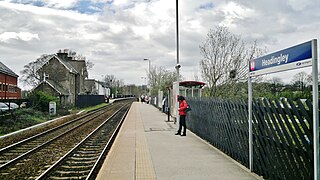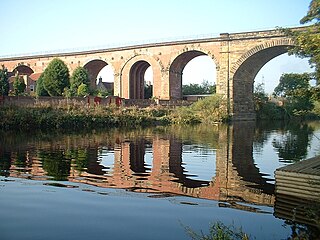
Arthington is a small village in Wharfedale, in the City of Leeds metropolitan borough in West Yorkshire, England. It is a civil parish which, according to the 2011 census, had a population of 532 and is in the LS21 postcode district with Otley as its post town. It is in the Otley ward of the City of Leeds, and the Leeds North West parliamentary constituency.

The Harrogate line is a passenger rail line through parts of North Yorkshire and the West Yorkshire area of northern England connecting Leeds to York by way of Harrogate and Knaresborough. Service on the line is operated by Northern, with a few additional workings by London North Eastern Railway starting and terminating at Harrogate. West Yorkshire Metro's bus and rail MetroCard ticket is available for journeys between Leeds and Harrogate.

Headingley railway station is off Kirkstall Lane in Leeds, West Yorkshire, England, on the Harrogate Line, 3 miles (5 km) north west of Leeds. The station was opened in 1849 by the Leeds & Thirsk Railway, later part of the Leeds Northern Railway to Northallerton.

The Leeds–Northallerton railway is a partly disused railway line between West and North Yorkshire, in northern England.

Pool-in-Wharfedale or Pool in Wharfedale, usually abbreviated to Pool, is a village and civil parish in the Lower Wharfedale area, 10 miles (16 km) north of Leeds city centre, 11 miles (18 km) north-east of Bradford, and 2 miles (3.2 km) east of Otley. It is in the City of Leeds metropolitan borough, West Yorkshire and within the historic boundaries of the West Riding of Yorkshire. It is in the LS21 (Otley) postcode district.

Castley is a village and civil parish in the Harrogate district of North Yorkshire, England. It lies on a bend in the River Wharfe about 10 miles (16 km) north of the centre of Leeds. The population of the civil parish was estimated at 70 in 2015. The village appears in the Domesday Book as Castleai, a combination of castel, and lēah, meaning the clearing near the fort.

The York and North Midland Railway (Y&NMR) was an English railway company that opened in 1839 connecting York with the Leeds and Selby Railway, and in 1840 extended this line to meet the North Midland Railway at Normanton near Leeds. Its first chairman was the railway financier George Hudson, who had been called the railway king.

Arthington railway station served the village of Arthington in the English county of West Yorkshire, near the North Yorkshire town of Harrogate.

Bramhope Tunnel is on the Harrogate Line between Horsforth station and the Arthington Viaduct in West Yorkshire, England. Services through the railway tunnel are operated mainly by Northern. The tunnel was constructed during 1845–1849 by the Leeds and Thirsk Railway. It is notable for its 2.138-mile (3.441 km) length and its Grade II listed, crenellated north portal. The deaths of 24 men who were killed during its construction are commemorated in Otley churchyard by a monument that is a replica of the tunnel's north portal.

The Otley and Ilkley Joint Railway was a railway line running between the towns of Otley and Ilkley in West Yorkshire. The line was managed and run jointly by the Midland Railway (MR) and the North Eastern Railway (NER) and was 6+1⁄2 miles (10 km) long. Opened to passenger traffic on 1 August 1865 and freight traffic some months later, the line ran for almost 100 years before partial closure in July 1965 when the line to Otley closed. Today passenger services run over the rest of the line as part of the West Yorkshire Passenger Transport Executive (WYPTE) Wharfedale Line.

The Leeds Northern Railway (LNR), originally the Leeds and Thirsk Railway, was an English railway company that built and opened a line from Leeds to Stockton via Harrogate and Thirsk. In 1845 the Leeds and Thirsk Railway received permission for a line from Leeds to Thirsk, part of which opened in 1848, but problems building the Bramhope Tunnel delayed trains operating into Leeds until 1849.

Crimple Valley Viaduct, also known as Crimple Viaduct and Crimple Beck Viaduct is a railway viaduct which crosses the Crimple Valley between Pannal railway station and Hornbeam Park railway station in North Yorkshire. It is a Grade II* listed structure.
The East and West Yorkshire Junction Railway was a railway company established in 1846 between the Leeds and Thirsk Railway at Knaresborough and the York, Newcastle and Berwick Railway near York, England. The company merged into the York and North Midland Railway in 1852.

The Leeds and York Railway was a proposed railway line, promoted in the mid 1840s, intended to connect York and Leeds. The line lost a significant promoter, the Manchester and Leeds Railway in 1845/6 as a result of a non-competition arrangement between that company and the York and North Midland Railway.

The Nidderdale Greenway is a 4-mile (6.4 km) path that runs between Harrogate and Ripley in North Yorkshire, England. It uses a former railway line that ran between Harrogate and Pateley Bridge as its course. The route connects to other cycle paths including the Way of the Roses.

Knaresborough Viaduct is a viaduct in the North Yorkshire town of Knaresborough, England. The viaduct carries the Harrogate line over the River Nidd in the town. The viaduct was supposed to have opened in 1848, but the first construction collapsed into the river very near to completion, which necessitated a new viaduct and delayed the opening of the line through Knaresborough by three years.

Yarm Viaduct carries railway traffic above the town of Yarm and across the River Tees straddling the boundary between North Yorkshire and County Durham in northern England. The railway it is situated on, runs between Northallerton and Eaglescliffe, and was opened in 1852 as part of the extension of the Leeds Northern Railway to Stockton-on-Tees. The line and viaduct are currently owned and maintained by Network Rail and carries passenger traffic for TransPennine Express and Grand Central train operating companies. It also sees a variety of freight traffic.

Kirkstall Road Viaduct is a Grade II listed railway viaduct carrying the Harrogate line over the A65 Kirkstall Road, the River Aire, and the Leeds and Liverpool Canal in Burley, Leeds, West Yorkshire. It was built in 1849 by the engineer Thomas Grainger for the Leeds and Thirsk Railway. The viaduct, which is approximately 440 m (0.27 mi), is a significant local landmark due to the wide, shallow nature of the valley it crosses.

Arten Gill Viaduct is an eleven-arch railway bridge in Dentdale, Cumbria, England. The viaduct carries the Settle to Carlisle railway line over Artengill Beck. The viaduct was originally designed to be further west, which is lower down the steep valley side, but by moving the line slightly eastwards, the viaduct could be installed at a higher location, thereby using fewer materials in its height. Arten Gill Viaduct is constructed partly from Dent Marble in the inside of the arches instead of the more usual brick. Dent Marble is a type of dark limestone which was quarried from Artengill beneath the viaduct itself. The viaduct is a grade II listed structure, and a scheduled monument.

Conisbrough Viaduct is a former railway viaduct, near to Cadeby and Conisbrough in South Yorkshire, England. The viaduct consists of two sections of brick and stone on each bank, connected by a lattice girder section, some 113–116 feet (34–35 m) over the River Don. The height and space were required should shipping need to navigate along the river. The viaduct carried the Dearne Valley Railway over the River Don between 1909 and 1966, after closure it was converted into a foot and cycle path. The structure is grade II listed, and is notable for being one of the first bridges in Britain to be built using a rope system above the viaduct known as a "Blondin".



















